Case Study Analysis: Leadership and Organizational Issues
VerifiedAdded on 2020/03/16
|17
|3551
|47
Case Study
AI Summary
This case study analyzes the organizational challenges faced by B.R. Richardson Timber Products Corporation, a family-owned business comprising four small enterprises. The analysis, based on interviews and observations, identifies key issues including ineffective leadership styles, worker inexperience, poor communication channels, and low worker morale. The study highlights the impact of a dictatorial management approach, inadequate training, and disorganized physical structures. The report then discusses the identified problems, proposing recommendations such as staff empowerment and training, improved communication strategies, and addressing the need for a more conducive working environment to enhance worker motivation and improve overall organizational performance. The study concludes with the need for implementing changes to improve leadership, communication, and employee satisfaction within the company.
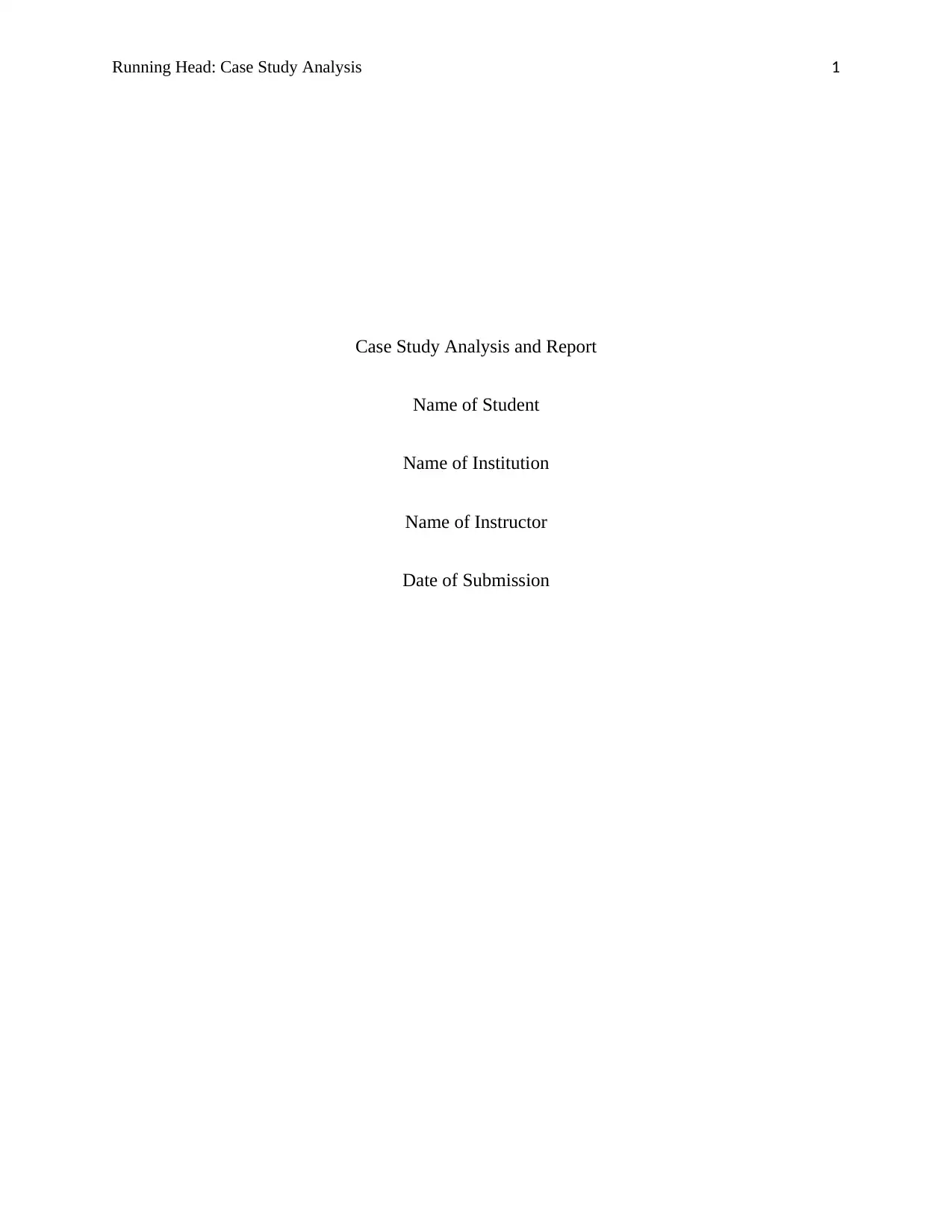
Running Head: Case Study Analysis 1
Case Study Analysis and Report
Name of Student
Name of Institution
Name of Instructor
Date of Submission
Case Study Analysis and Report
Name of Student
Name of Institution
Name of Instructor
Date of Submission
Paraphrase This Document
Need a fresh take? Get an instant paraphrase of this document with our AI Paraphraser
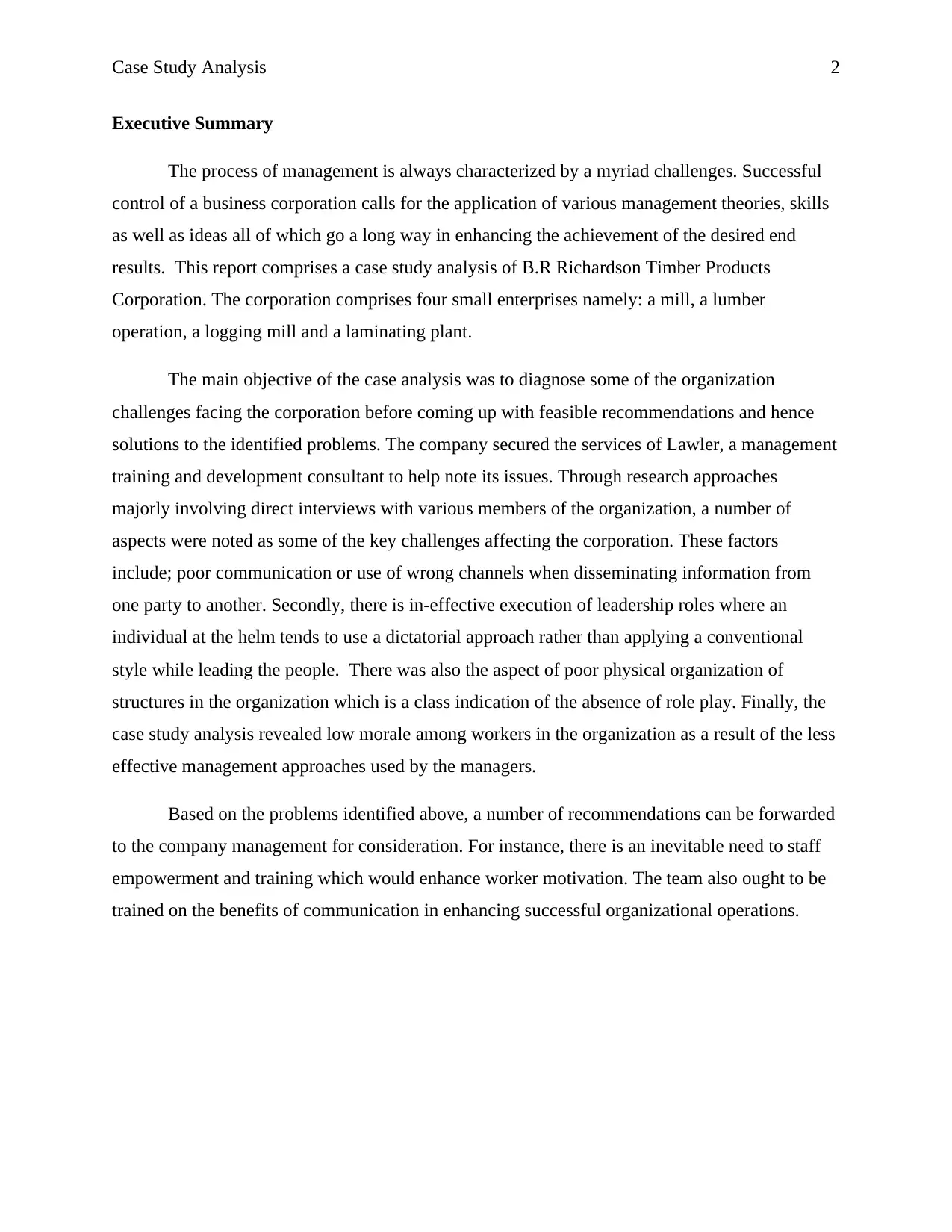
Case Study Analysis 2
Executive Summary
The process of management is always characterized by a myriad challenges. Successful
control of a business corporation calls for the application of various management theories, skills
as well as ideas all of which go a long way in enhancing the achievement of the desired end
results. This report comprises a case study analysis of B.R Richardson Timber Products
Corporation. The corporation comprises four small enterprises namely: a mill, a lumber
operation, a logging mill and a laminating plant.
The main objective of the case analysis was to diagnose some of the organization
challenges facing the corporation before coming up with feasible recommendations and hence
solutions to the identified problems. The company secured the services of Lawler, a management
training and development consultant to help note its issues. Through research approaches
majorly involving direct interviews with various members of the organization, a number of
aspects were noted as some of the key challenges affecting the corporation. These factors
include; poor communication or use of wrong channels when disseminating information from
one party to another. Secondly, there is in-effective execution of leadership roles where an
individual at the helm tends to use a dictatorial approach rather than applying a conventional
style while leading the people. There was also the aspect of poor physical organization of
structures in the organization which is a class indication of the absence of role play. Finally, the
case study analysis revealed low morale among workers in the organization as a result of the less
effective management approaches used by the managers.
Based on the problems identified above, a number of recommendations can be forwarded
to the company management for consideration. For instance, there is an inevitable need to staff
empowerment and training which would enhance worker motivation. The team also ought to be
trained on the benefits of communication in enhancing successful organizational operations.
Executive Summary
The process of management is always characterized by a myriad challenges. Successful
control of a business corporation calls for the application of various management theories, skills
as well as ideas all of which go a long way in enhancing the achievement of the desired end
results. This report comprises a case study analysis of B.R Richardson Timber Products
Corporation. The corporation comprises four small enterprises namely: a mill, a lumber
operation, a logging mill and a laminating plant.
The main objective of the case analysis was to diagnose some of the organization
challenges facing the corporation before coming up with feasible recommendations and hence
solutions to the identified problems. The company secured the services of Lawler, a management
training and development consultant to help note its issues. Through research approaches
majorly involving direct interviews with various members of the organization, a number of
aspects were noted as some of the key challenges affecting the corporation. These factors
include; poor communication or use of wrong channels when disseminating information from
one party to another. Secondly, there is in-effective execution of leadership roles where an
individual at the helm tends to use a dictatorial approach rather than applying a conventional
style while leading the people. There was also the aspect of poor physical organization of
structures in the organization which is a class indication of the absence of role play. Finally, the
case study analysis revealed low morale among workers in the organization as a result of the less
effective management approaches used by the managers.
Based on the problems identified above, a number of recommendations can be forwarded
to the company management for consideration. For instance, there is an inevitable need to staff
empowerment and training which would enhance worker motivation. The team also ought to be
trained on the benefits of communication in enhancing successful organizational operations.
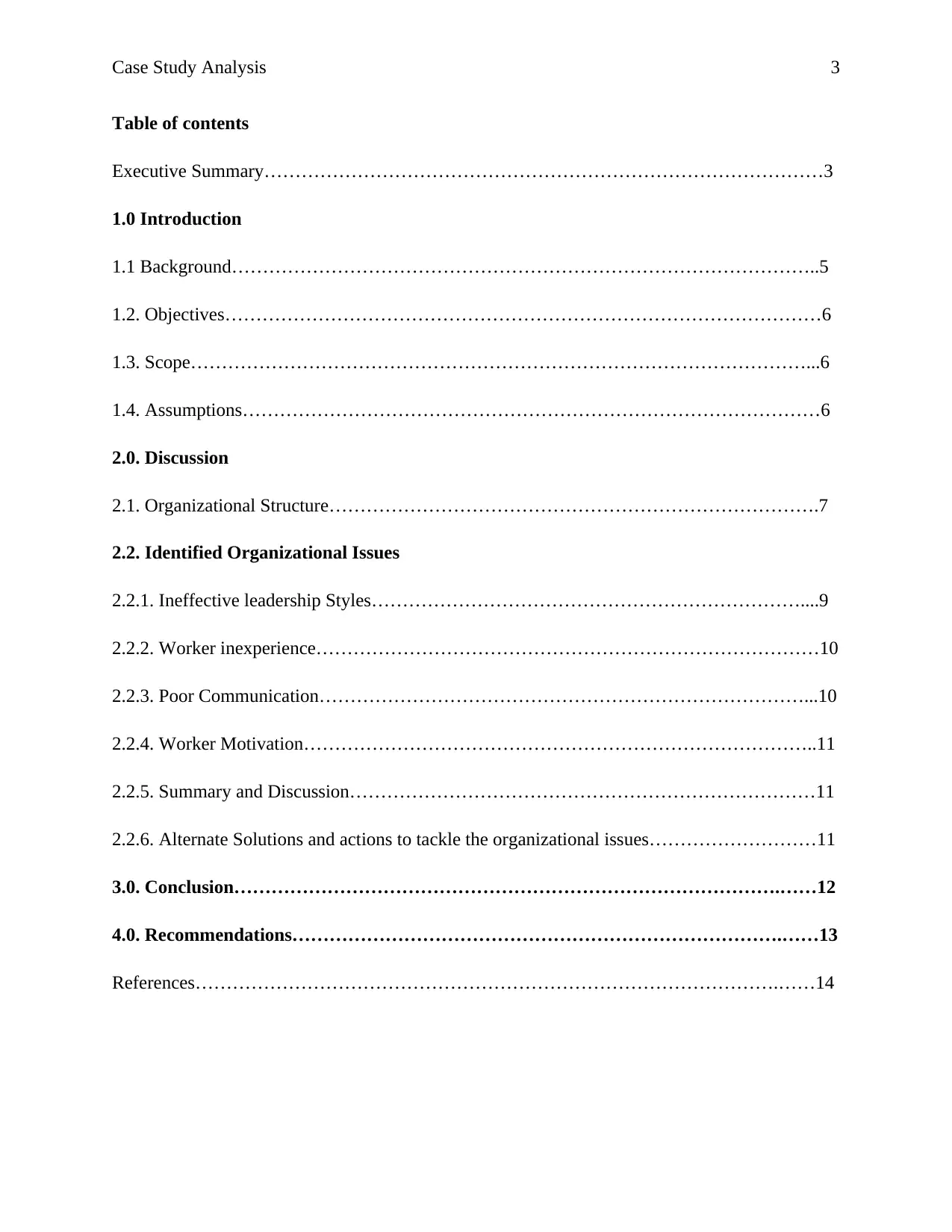
Case Study Analysis 3
Table of contents
Executive Summary………………………………………………………………………………3
1.0 Introduction
1.1 Background…………………………………………………………………………………..5
1.2. Objectives……………………………………………………………………………………6
1.3. Scope………………………………………………………………………………………...6
1.4. Assumptions…………………………………………………………………………………6
2.0. Discussion
2.1. Organizational Structure…………………………………………………………………….7
2.2. Identified Organizational Issues
2.2.1. Ineffective leadership Styles……………………………………………………………....9
2.2.2. Worker inexperience………………………………………………………………………10
2.2.3. Poor Communication……………………………………………………………………...10
2.2.4. Worker Motivation………………………………………………………………………..11
2.2.5. Summary and Discussion…………………………………………………………………11
2.2.6. Alternate Solutions and actions to tackle the organizational issues………………………11
3.0. Conclusion…………………………………………………………………………….……12
4.0. Recommendations…………………………………………………………………….……13
References………………………………………………………………………………….……14
Table of contents
Executive Summary………………………………………………………………………………3
1.0 Introduction
1.1 Background…………………………………………………………………………………..5
1.2. Objectives……………………………………………………………………………………6
1.3. Scope………………………………………………………………………………………...6
1.4. Assumptions…………………………………………………………………………………6
2.0. Discussion
2.1. Organizational Structure…………………………………………………………………….7
2.2. Identified Organizational Issues
2.2.1. Ineffective leadership Styles……………………………………………………………....9
2.2.2. Worker inexperience………………………………………………………………………10
2.2.3. Poor Communication……………………………………………………………………...10
2.2.4. Worker Motivation………………………………………………………………………..11
2.2.5. Summary and Discussion…………………………………………………………………11
2.2.6. Alternate Solutions and actions to tackle the organizational issues………………………11
3.0. Conclusion…………………………………………………………………………….……12
4.0. Recommendations…………………………………………………………………….……13
References………………………………………………………………………………….……14
⊘ This is a preview!⊘
Do you want full access?
Subscribe today to unlock all pages.

Trusted by 1+ million students worldwide
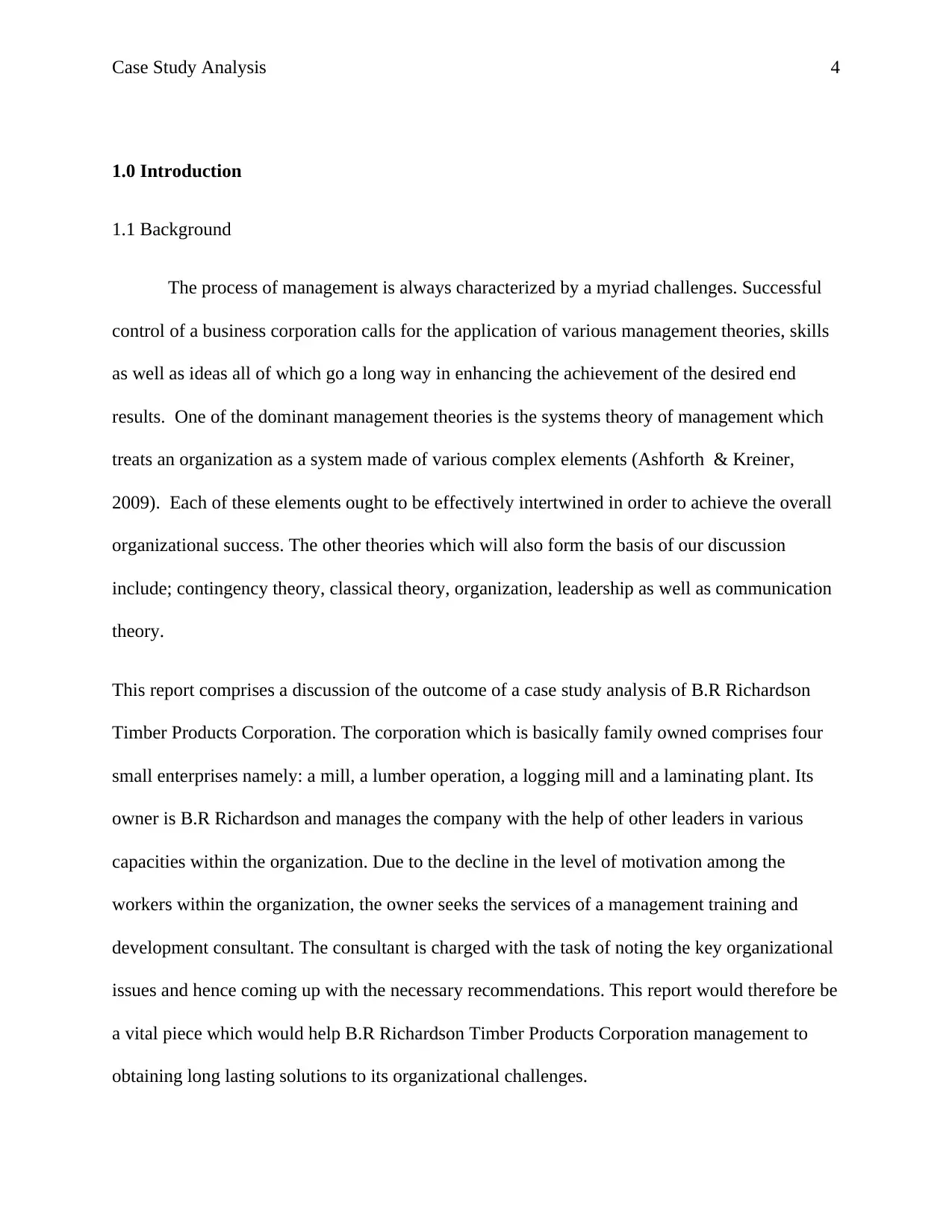
Case Study Analysis 4
1.0 Introduction
1.1 Background
The process of management is always characterized by a myriad challenges. Successful
control of a business corporation calls for the application of various management theories, skills
as well as ideas all of which go a long way in enhancing the achievement of the desired end
results. One of the dominant management theories is the systems theory of management which
treats an organization as a system made of various complex elements (Ashforth & Kreiner,
2009). Each of these elements ought to be effectively intertwined in order to achieve the overall
organizational success. The other theories which will also form the basis of our discussion
include; contingency theory, classical theory, organization, leadership as well as communication
theory.
This report comprises a discussion of the outcome of a case study analysis of B.R Richardson
Timber Products Corporation. The corporation which is basically family owned comprises four
small enterprises namely: a mill, a lumber operation, a logging mill and a laminating plant. Its
owner is B.R Richardson and manages the company with the help of other leaders in various
capacities within the organization. Due to the decline in the level of motivation among the
workers within the organization, the owner seeks the services of a management training and
development consultant. The consultant is charged with the task of noting the key organizational
issues and hence coming up with the necessary recommendations. This report would therefore be
a vital piece which would help B.R Richardson Timber Products Corporation management to
obtaining long lasting solutions to its organizational challenges.
1.0 Introduction
1.1 Background
The process of management is always characterized by a myriad challenges. Successful
control of a business corporation calls for the application of various management theories, skills
as well as ideas all of which go a long way in enhancing the achievement of the desired end
results. One of the dominant management theories is the systems theory of management which
treats an organization as a system made of various complex elements (Ashforth & Kreiner,
2009). Each of these elements ought to be effectively intertwined in order to achieve the overall
organizational success. The other theories which will also form the basis of our discussion
include; contingency theory, classical theory, organization, leadership as well as communication
theory.
This report comprises a discussion of the outcome of a case study analysis of B.R Richardson
Timber Products Corporation. The corporation which is basically family owned comprises four
small enterprises namely: a mill, a lumber operation, a logging mill and a laminating plant. Its
owner is B.R Richardson and manages the company with the help of other leaders in various
capacities within the organization. Due to the decline in the level of motivation among the
workers within the organization, the owner seeks the services of a management training and
development consultant. The consultant is charged with the task of noting the key organizational
issues and hence coming up with the necessary recommendations. This report would therefore be
a vital piece which would help B.R Richardson Timber Products Corporation management to
obtaining long lasting solutions to its organizational challenges.
Paraphrase This Document
Need a fresh take? Get an instant paraphrase of this document with our AI Paraphraser
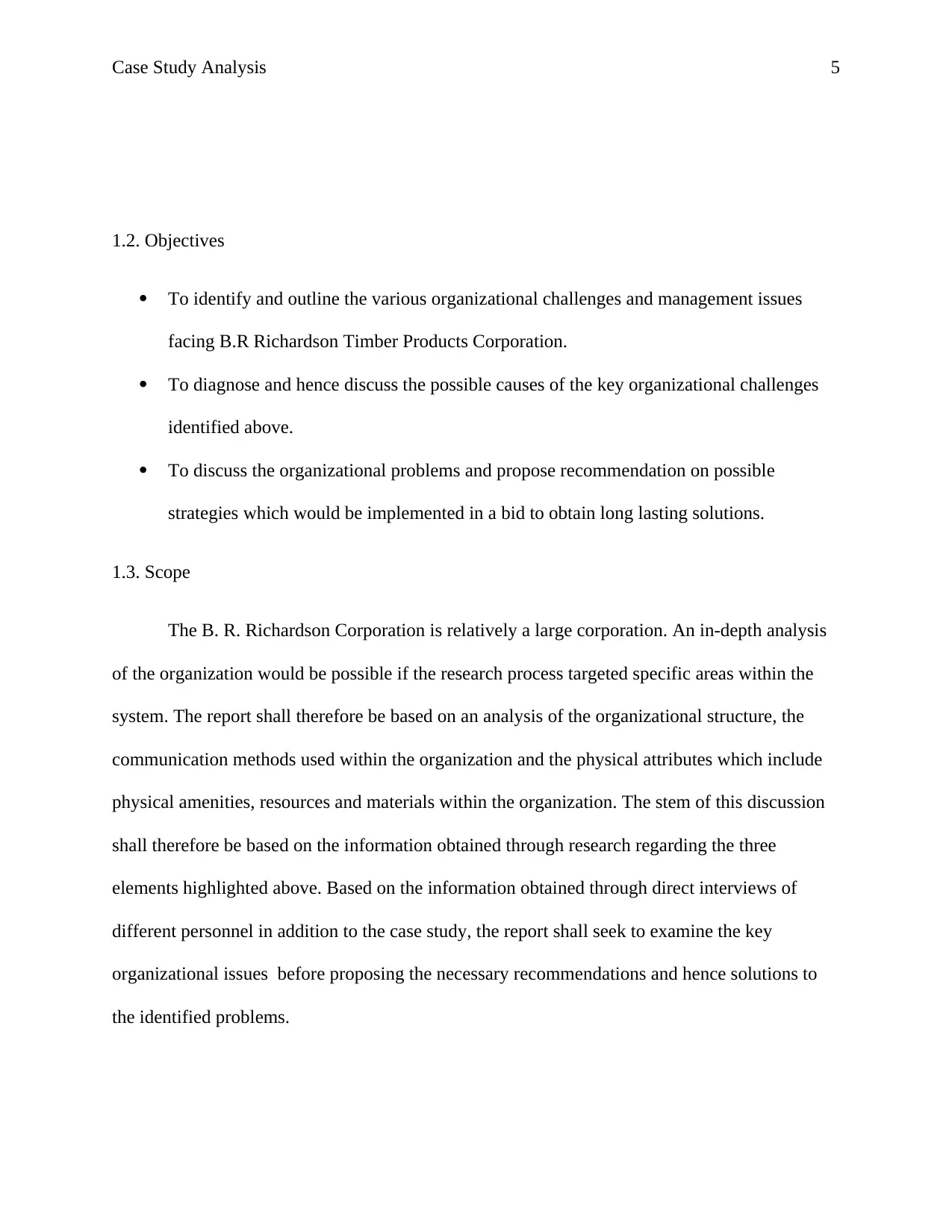
Case Study Analysis 5
1.2. Objectives
To identify and outline the various organizational challenges and management issues
facing B.R Richardson Timber Products Corporation.
To diagnose and hence discuss the possible causes of the key organizational challenges
identified above.
To discuss the organizational problems and propose recommendation on possible
strategies which would be implemented in a bid to obtain long lasting solutions.
1.3. Scope
The B. R. Richardson Corporation is relatively a large corporation. An in-depth analysis
of the organization would be possible if the research process targeted specific areas within the
system. The report shall therefore be based on an analysis of the organizational structure, the
communication methods used within the organization and the physical attributes which include
physical amenities, resources and materials within the organization. The stem of this discussion
shall therefore be based on the information obtained through research regarding the three
elements highlighted above. Based on the information obtained through direct interviews of
different personnel in addition to the case study, the report shall seek to examine the key
organizational issues before proposing the necessary recommendations and hence solutions to
the identified problems.
1.2. Objectives
To identify and outline the various organizational challenges and management issues
facing B.R Richardson Timber Products Corporation.
To diagnose and hence discuss the possible causes of the key organizational challenges
identified above.
To discuss the organizational problems and propose recommendation on possible
strategies which would be implemented in a bid to obtain long lasting solutions.
1.3. Scope
The B. R. Richardson Corporation is relatively a large corporation. An in-depth analysis
of the organization would be possible if the research process targeted specific areas within the
system. The report shall therefore be based on an analysis of the organizational structure, the
communication methods used within the organization and the physical attributes which include
physical amenities, resources and materials within the organization. The stem of this discussion
shall therefore be based on the information obtained through research regarding the three
elements highlighted above. Based on the information obtained through direct interviews of
different personnel in addition to the case study, the report shall seek to examine the key
organizational issues before proposing the necessary recommendations and hence solutions to
the identified problems.
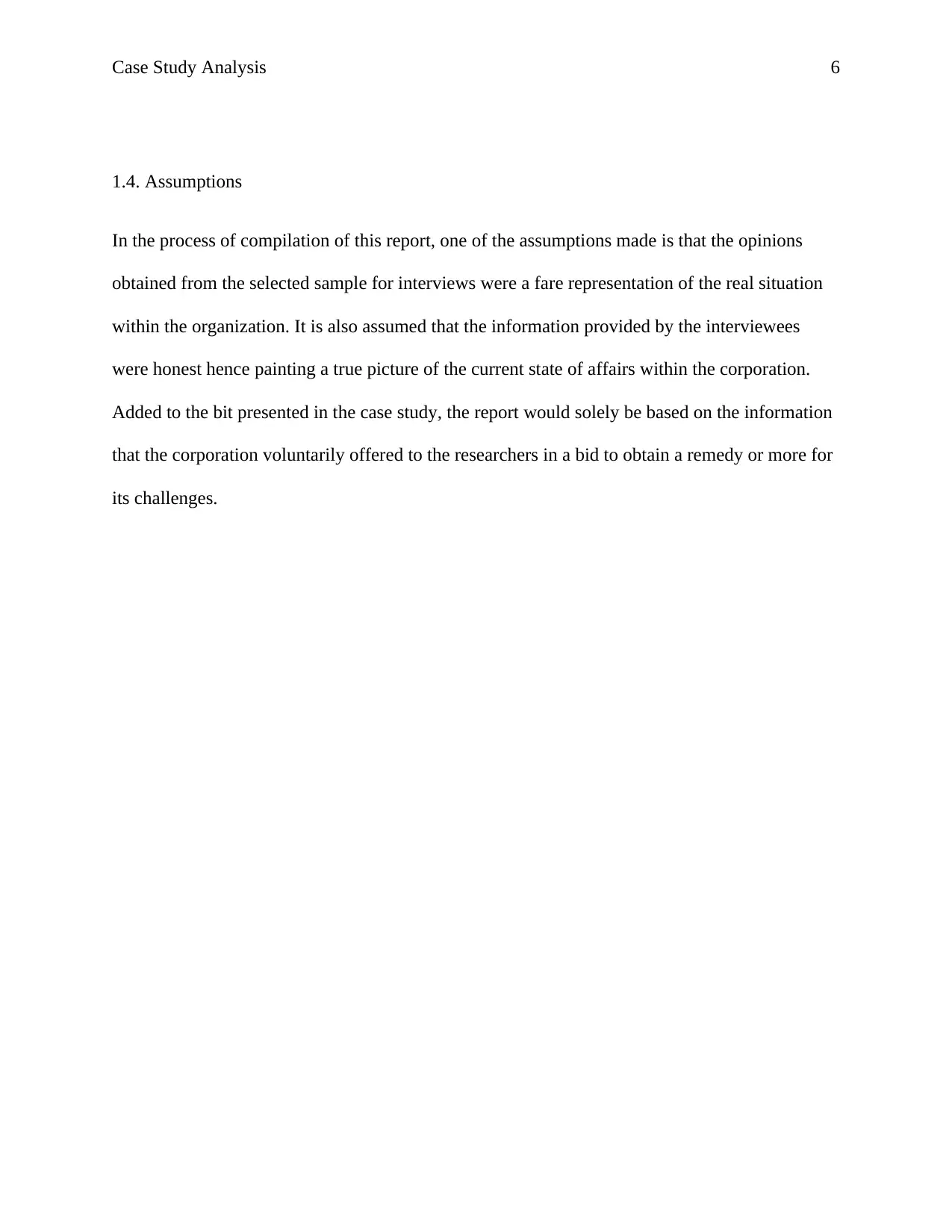
Case Study Analysis 6
1.4. Assumptions
In the process of compilation of this report, one of the assumptions made is that the opinions
obtained from the selected sample for interviews were a fare representation of the real situation
within the organization. It is also assumed that the information provided by the interviewees
were honest hence painting a true picture of the current state of affairs within the corporation.
Added to the bit presented in the case study, the report would solely be based on the information
that the corporation voluntarily offered to the researchers in a bid to obtain a remedy or more for
its challenges.
1.4. Assumptions
In the process of compilation of this report, one of the assumptions made is that the opinions
obtained from the selected sample for interviews were a fare representation of the real situation
within the organization. It is also assumed that the information provided by the interviewees
were honest hence painting a true picture of the current state of affairs within the corporation.
Added to the bit presented in the case study, the report would solely be based on the information
that the corporation voluntarily offered to the researchers in a bid to obtain a remedy or more for
its challenges.
⊘ This is a preview!⊘
Do you want full access?
Subscribe today to unlock all pages.

Trusted by 1+ million students worldwide
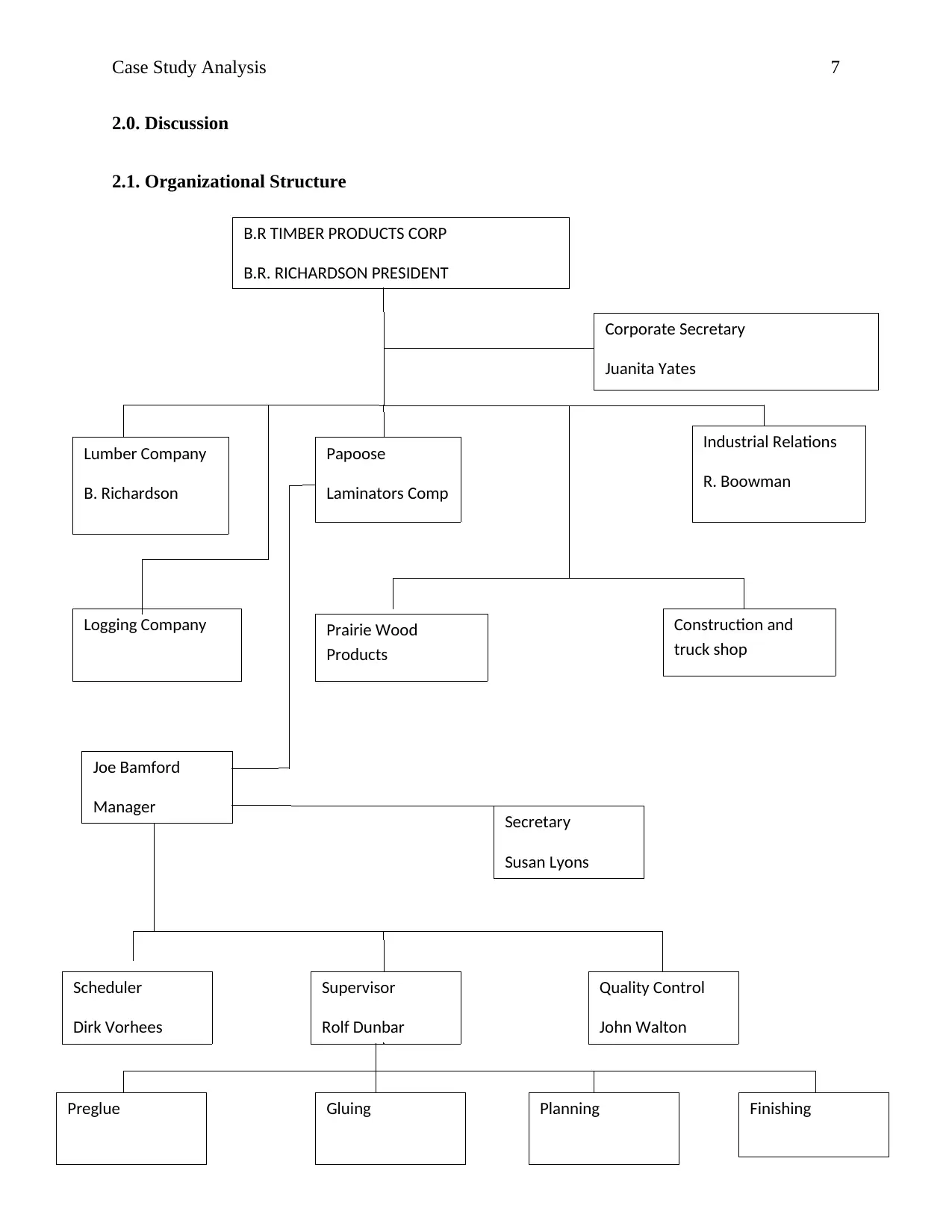
Case Study Analysis 7
2.0. Discussion
2.1. Organizational Structure
B.R TIMBER PRODUCTS CORP
B.R. RICHARDSON PRESIDENT
Corporate Secretary
Juanita Yates
Papoose
Laminators Comp
Lumber Company
B. Richardson
Industrial Relations
R. Boowman
Logging Company Prairie Wood
Products
Construction and
truck shop
Joe Bamford
Manager Secretary
Susan Lyons
Scheduler
Dirk Vorhees
Supervisor
Rolf Dunbar
Quality Control
John Walton
Preglue Gluing Planning Finishing
2.0. Discussion
2.1. Organizational Structure
B.R TIMBER PRODUCTS CORP
B.R. RICHARDSON PRESIDENT
Corporate Secretary
Juanita Yates
Papoose
Laminators Comp
Lumber Company
B. Richardson
Industrial Relations
R. Boowman
Logging Company Prairie Wood
Products
Construction and
truck shop
Joe Bamford
Manager Secretary
Susan Lyons
Scheduler
Dirk Vorhees
Supervisor
Rolf Dunbar
Quality Control
John Walton
Preglue Gluing Planning Finishing
Paraphrase This Document
Need a fresh take? Get an instant paraphrase of this document with our AI Paraphraser
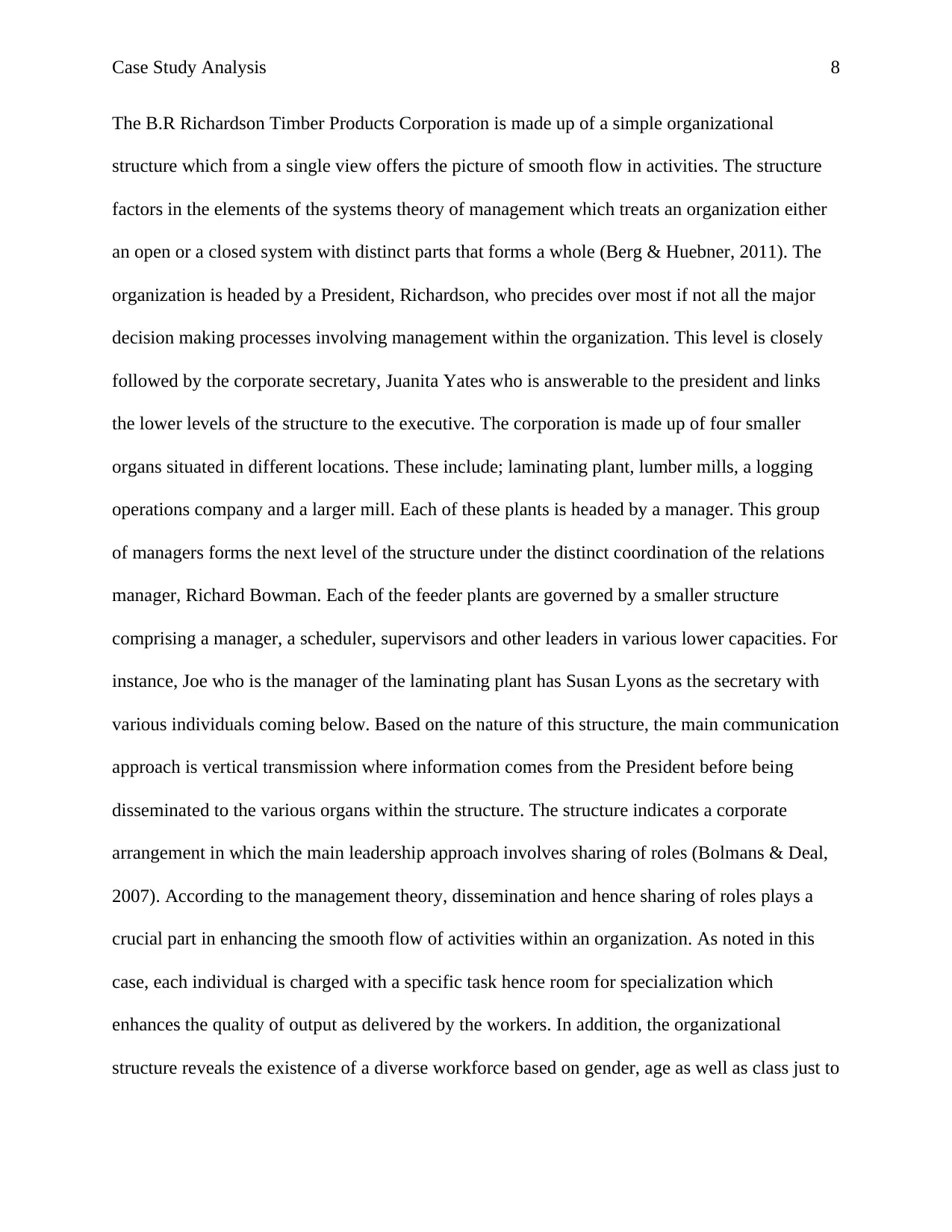
Case Study Analysis 8
The B.R Richardson Timber Products Corporation is made up of a simple organizational
structure which from a single view offers the picture of smooth flow in activities. The structure
factors in the elements of the systems theory of management which treats an organization either
an open or a closed system with distinct parts that forms a whole (Berg & Huebner, 2011). The
organization is headed by a President, Richardson, who precides over most if not all the major
decision making processes involving management within the organization. This level is closely
followed by the corporate secretary, Juanita Yates who is answerable to the president and links
the lower levels of the structure to the executive. The corporation is made up of four smaller
organs situated in different locations. These include; laminating plant, lumber mills, a logging
operations company and a larger mill. Each of these plants is headed by a manager. This group
of managers forms the next level of the structure under the distinct coordination of the relations
manager, Richard Bowman. Each of the feeder plants are governed by a smaller structure
comprising a manager, a scheduler, supervisors and other leaders in various lower capacities. For
instance, Joe who is the manager of the laminating plant has Susan Lyons as the secretary with
various individuals coming below. Based on the nature of this structure, the main communication
approach is vertical transmission where information comes from the President before being
disseminated to the various organs within the structure. The structure indicates a corporate
arrangement in which the main leadership approach involves sharing of roles (Bolmans & Deal,
2007). According to the management theory, dissemination and hence sharing of roles plays a
crucial part in enhancing the smooth flow of activities within an organization. As noted in this
case, each individual is charged with a specific task hence room for specialization which
enhances the quality of output as delivered by the workers. In addition, the organizational
structure reveals the existence of a diverse workforce based on gender, age as well as class just to
The B.R Richardson Timber Products Corporation is made up of a simple organizational
structure which from a single view offers the picture of smooth flow in activities. The structure
factors in the elements of the systems theory of management which treats an organization either
an open or a closed system with distinct parts that forms a whole (Berg & Huebner, 2011). The
organization is headed by a President, Richardson, who precides over most if not all the major
decision making processes involving management within the organization. This level is closely
followed by the corporate secretary, Juanita Yates who is answerable to the president and links
the lower levels of the structure to the executive. The corporation is made up of four smaller
organs situated in different locations. These include; laminating plant, lumber mills, a logging
operations company and a larger mill. Each of these plants is headed by a manager. This group
of managers forms the next level of the structure under the distinct coordination of the relations
manager, Richard Bowman. Each of the feeder plants are governed by a smaller structure
comprising a manager, a scheduler, supervisors and other leaders in various lower capacities. For
instance, Joe who is the manager of the laminating plant has Susan Lyons as the secretary with
various individuals coming below. Based on the nature of this structure, the main communication
approach is vertical transmission where information comes from the President before being
disseminated to the various organs within the structure. The structure indicates a corporate
arrangement in which the main leadership approach involves sharing of roles (Bolmans & Deal,
2007). According to the management theory, dissemination and hence sharing of roles plays a
crucial part in enhancing the smooth flow of activities within an organization. As noted in this
case, each individual is charged with a specific task hence room for specialization which
enhances the quality of output as delivered by the workers. In addition, the organizational
structure reveals the existence of a diverse workforce based on gender, age as well as class just to
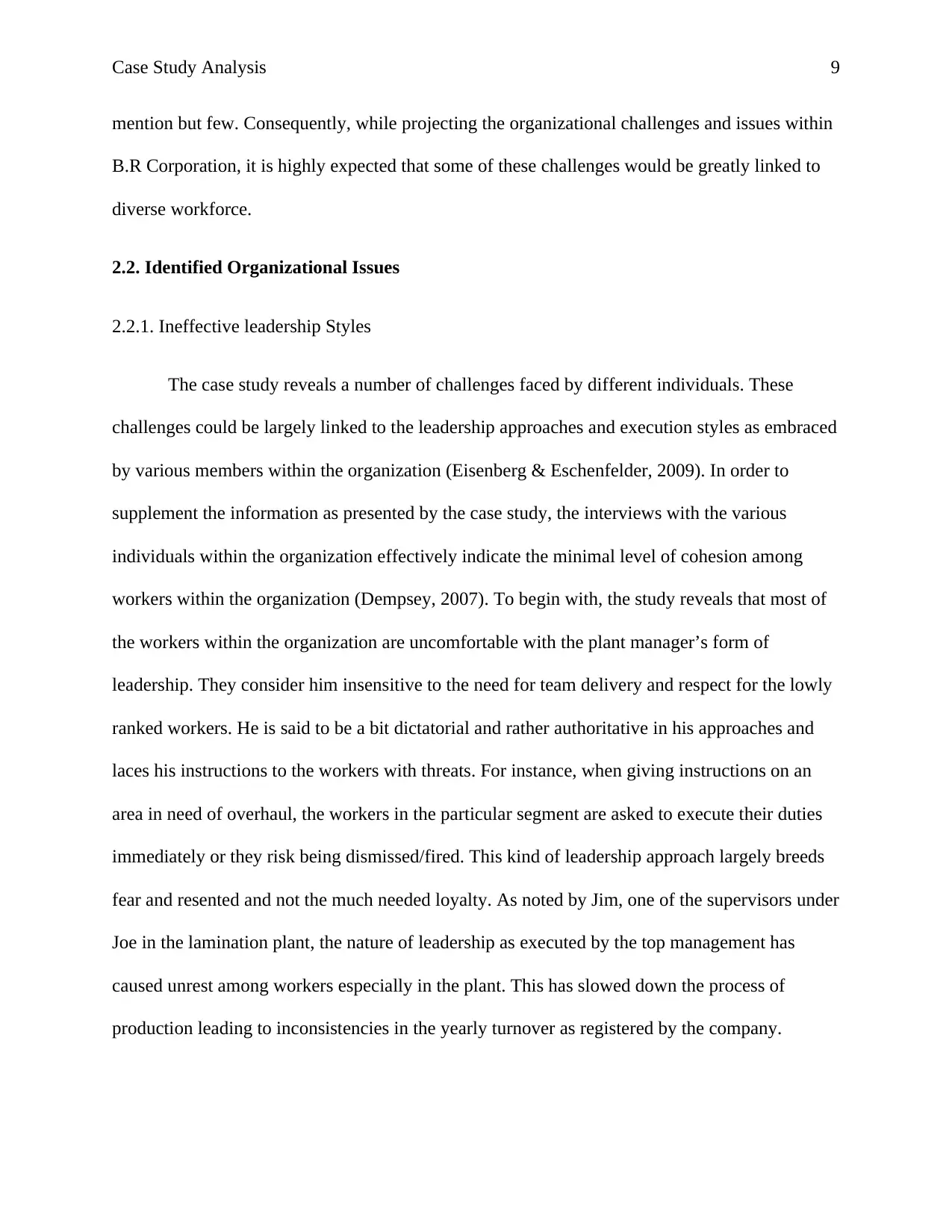
Case Study Analysis 9
mention but few. Consequently, while projecting the organizational challenges and issues within
B.R Corporation, it is highly expected that some of these challenges would be greatly linked to
diverse workforce.
2.2. Identified Organizational Issues
2.2.1. Ineffective leadership Styles
The case study reveals a number of challenges faced by different individuals. These
challenges could be largely linked to the leadership approaches and execution styles as embraced
by various members within the organization (Eisenberg & Eschenfelder, 2009). In order to
supplement the information as presented by the case study, the interviews with the various
individuals within the organization effectively indicate the minimal level of cohesion among
workers within the organization (Dempsey, 2007). To begin with, the study reveals that most of
the workers within the organization are uncomfortable with the plant manager’s form of
leadership. They consider him insensitive to the need for team delivery and respect for the lowly
ranked workers. He is said to be a bit dictatorial and rather authoritative in his approaches and
laces his instructions to the workers with threats. For instance, when giving instructions on an
area in need of overhaul, the workers in the particular segment are asked to execute their duties
immediately or they risk being dismissed/fired. This kind of leadership approach largely breeds
fear and resented and not the much needed loyalty. As noted by Jim, one of the supervisors under
Joe in the lamination plant, the nature of leadership as executed by the top management has
caused unrest among workers especially in the plant. This has slowed down the process of
production leading to inconsistencies in the yearly turnover as registered by the company.
mention but few. Consequently, while projecting the organizational challenges and issues within
B.R Corporation, it is highly expected that some of these challenges would be greatly linked to
diverse workforce.
2.2. Identified Organizational Issues
2.2.1. Ineffective leadership Styles
The case study reveals a number of challenges faced by different individuals. These
challenges could be largely linked to the leadership approaches and execution styles as embraced
by various members within the organization (Eisenberg & Eschenfelder, 2009). In order to
supplement the information as presented by the case study, the interviews with the various
individuals within the organization effectively indicate the minimal level of cohesion among
workers within the organization (Dempsey, 2007). To begin with, the study reveals that most of
the workers within the organization are uncomfortable with the plant manager’s form of
leadership. They consider him insensitive to the need for team delivery and respect for the lowly
ranked workers. He is said to be a bit dictatorial and rather authoritative in his approaches and
laces his instructions to the workers with threats. For instance, when giving instructions on an
area in need of overhaul, the workers in the particular segment are asked to execute their duties
immediately or they risk being dismissed/fired. This kind of leadership approach largely breeds
fear and resented and not the much needed loyalty. As noted by Jim, one of the supervisors under
Joe in the lamination plant, the nature of leadership as executed by the top management has
caused unrest among workers especially in the plant. This has slowed down the process of
production leading to inconsistencies in the yearly turnover as registered by the company.
⊘ This is a preview!⊘
Do you want full access?
Subscribe today to unlock all pages.

Trusted by 1+ million students worldwide
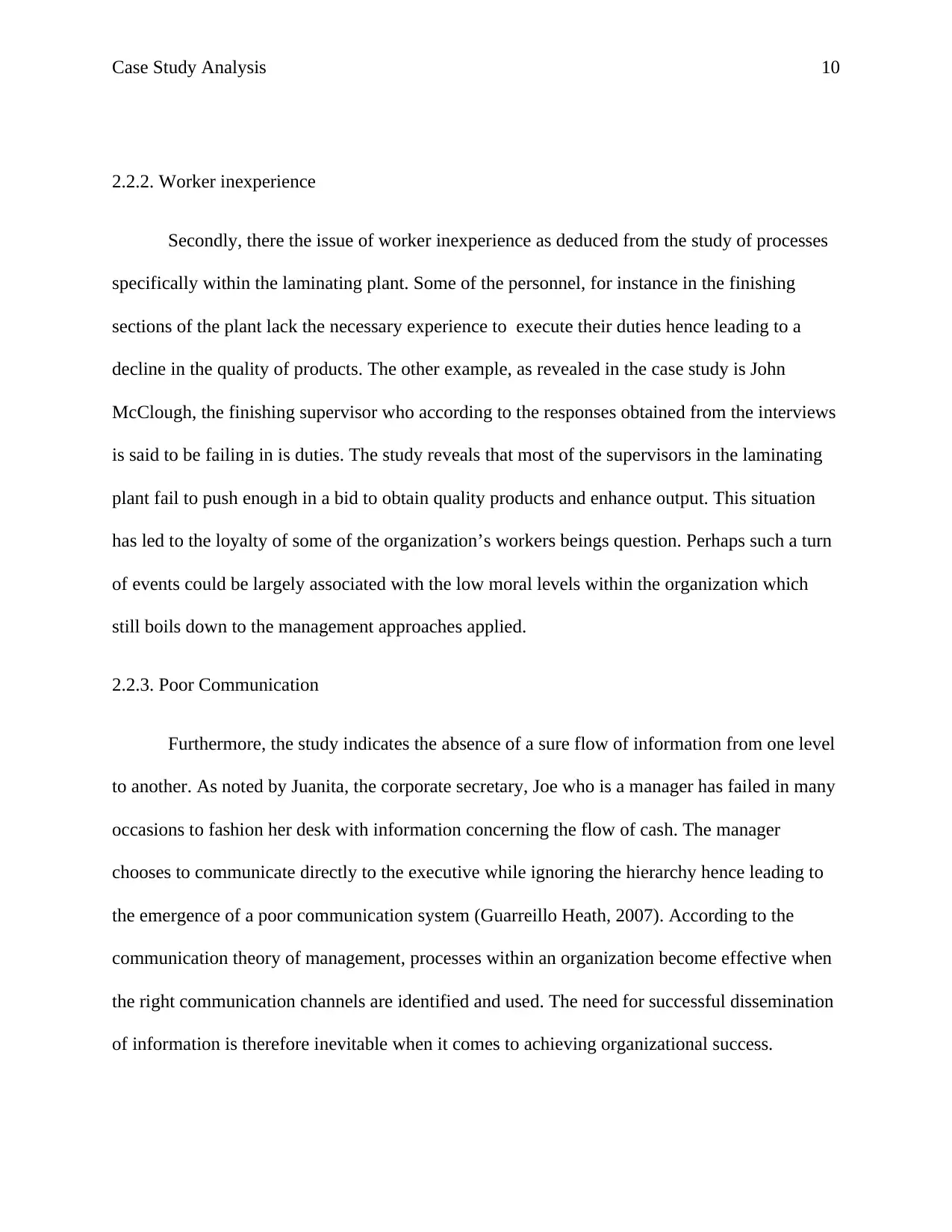
Case Study Analysis 10
2.2.2. Worker inexperience
Secondly, there the issue of worker inexperience as deduced from the study of processes
specifically within the laminating plant. Some of the personnel, for instance in the finishing
sections of the plant lack the necessary experience to execute their duties hence leading to a
decline in the quality of products. The other example, as revealed in the case study is John
McClough, the finishing supervisor who according to the responses obtained from the interviews
is said to be failing in is duties. The study reveals that most of the supervisors in the laminating
plant fail to push enough in a bid to obtain quality products and enhance output. This situation
has led to the loyalty of some of the organization’s workers beings question. Perhaps such a turn
of events could be largely associated with the low moral levels within the organization which
still boils down to the management approaches applied.
2.2.3. Poor Communication
Furthermore, the study indicates the absence of a sure flow of information from one level
to another. As noted by Juanita, the corporate secretary, Joe who is a manager has failed in many
occasions to fashion her desk with information concerning the flow of cash. The manager
chooses to communicate directly to the executive while ignoring the hierarchy hence leading to
the emergence of a poor communication system (Guarreillo Heath, 2007). According to the
communication theory of management, processes within an organization become effective when
the right communication channels are identified and used. The need for successful dissemination
of information is therefore inevitable when it comes to achieving organizational success.
2.2.2. Worker inexperience
Secondly, there the issue of worker inexperience as deduced from the study of processes
specifically within the laminating plant. Some of the personnel, for instance in the finishing
sections of the plant lack the necessary experience to execute their duties hence leading to a
decline in the quality of products. The other example, as revealed in the case study is John
McClough, the finishing supervisor who according to the responses obtained from the interviews
is said to be failing in is duties. The study reveals that most of the supervisors in the laminating
plant fail to push enough in a bid to obtain quality products and enhance output. This situation
has led to the loyalty of some of the organization’s workers beings question. Perhaps such a turn
of events could be largely associated with the low moral levels within the organization which
still boils down to the management approaches applied.
2.2.3. Poor Communication
Furthermore, the study indicates the absence of a sure flow of information from one level
to another. As noted by Juanita, the corporate secretary, Joe who is a manager has failed in many
occasions to fashion her desk with information concerning the flow of cash. The manager
chooses to communicate directly to the executive while ignoring the hierarchy hence leading to
the emergence of a poor communication system (Guarreillo Heath, 2007). According to the
communication theory of management, processes within an organization become effective when
the right communication channels are identified and used. The need for successful dissemination
of information is therefore inevitable when it comes to achieving organizational success.
Paraphrase This Document
Need a fresh take? Get an instant paraphrase of this document with our AI Paraphraser
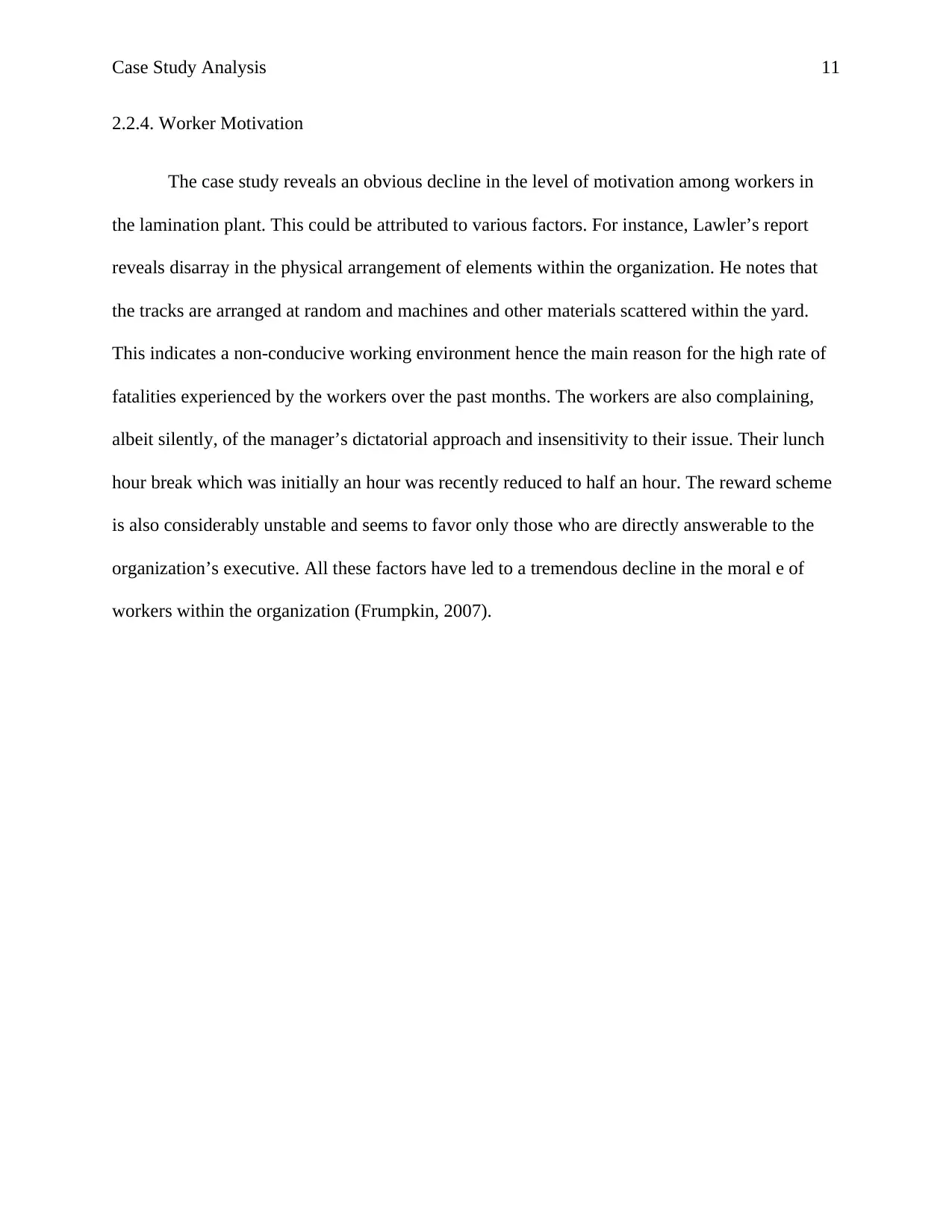
Case Study Analysis 11
2.2.4. Worker Motivation
The case study reveals an obvious decline in the level of motivation among workers in
the lamination plant. This could be attributed to various factors. For instance, Lawler’s report
reveals disarray in the physical arrangement of elements within the organization. He notes that
the tracks are arranged at random and machines and other materials scattered within the yard.
This indicates a non-conducive working environment hence the main reason for the high rate of
fatalities experienced by the workers over the past months. The workers are also complaining,
albeit silently, of the manager’s dictatorial approach and insensitivity to their issue. Their lunch
hour break which was initially an hour was recently reduced to half an hour. The reward scheme
is also considerably unstable and seems to favor only those who are directly answerable to the
organization’s executive. All these factors have led to a tremendous decline in the moral e of
workers within the organization (Frumpkin, 2007).
2.2.4. Worker Motivation
The case study reveals an obvious decline in the level of motivation among workers in
the lamination plant. This could be attributed to various factors. For instance, Lawler’s report
reveals disarray in the physical arrangement of elements within the organization. He notes that
the tracks are arranged at random and machines and other materials scattered within the yard.
This indicates a non-conducive working environment hence the main reason for the high rate of
fatalities experienced by the workers over the past months. The workers are also complaining,
albeit silently, of the manager’s dictatorial approach and insensitivity to their issue. Their lunch
hour break which was initially an hour was recently reduced to half an hour. The reward scheme
is also considerably unstable and seems to favor only those who are directly answerable to the
organization’s executive. All these factors have led to a tremendous decline in the moral e of
workers within the organization (Frumpkin, 2007).
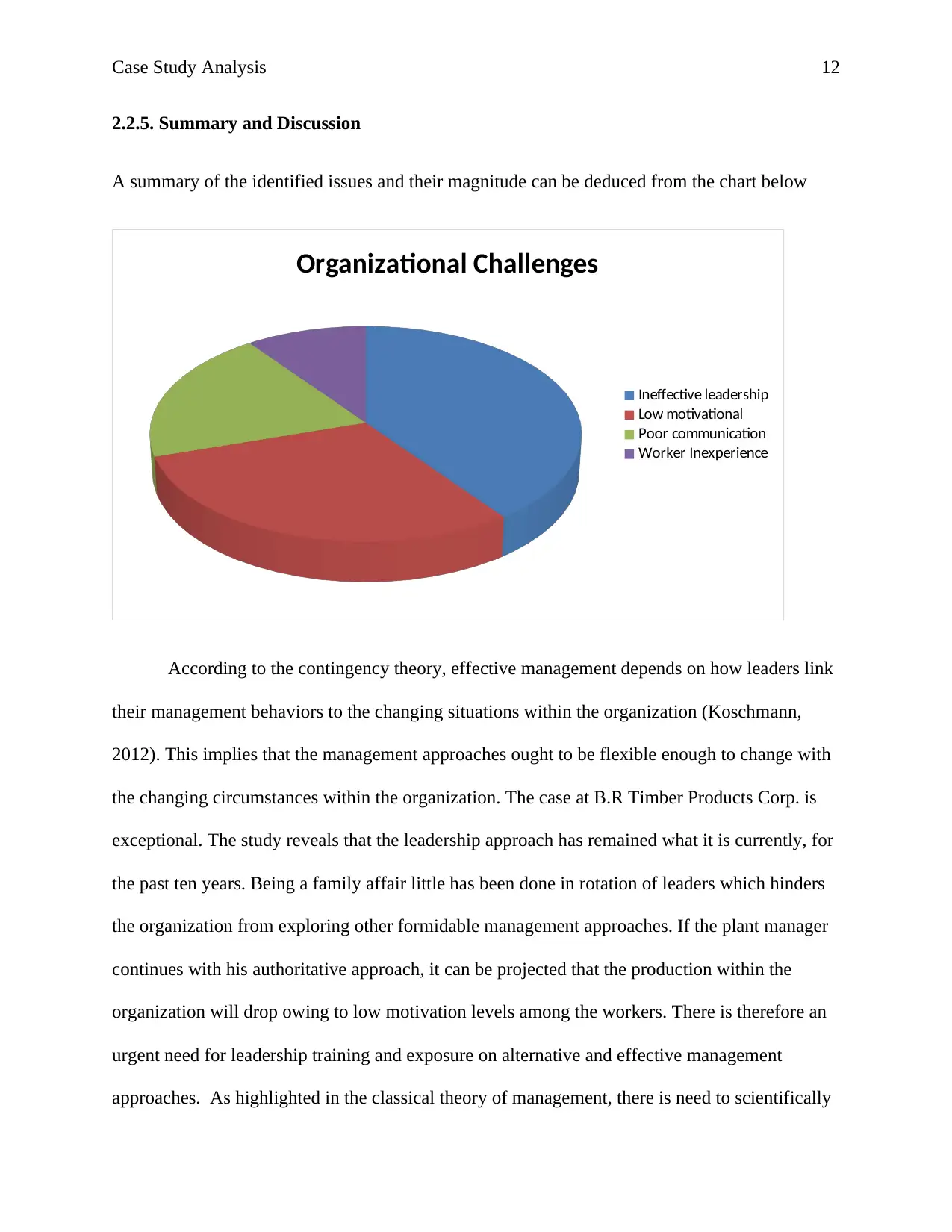
Case Study Analysis 12
2.2.5. Summary and Discussion
A summary of the identified issues and their magnitude can be deduced from the chart below
Organizational Challenges
Ineffective leadership
Low motivational
Poor communication
Worker Inexperience
According to the contingency theory, effective management depends on how leaders link
their management behaviors to the changing situations within the organization (Koschmann,
2012). This implies that the management approaches ought to be flexible enough to change with
the changing circumstances within the organization. The case at B.R Timber Products Corp. is
exceptional. The study reveals that the leadership approach has remained what it is currently, for
the past ten years. Being a family affair little has been done in rotation of leaders which hinders
the organization from exploring other formidable management approaches. If the plant manager
continues with his authoritative approach, it can be projected that the production within the
organization will drop owing to low motivation levels among the workers. There is therefore an
urgent need for leadership training and exposure on alternative and effective management
approaches. As highlighted in the classical theory of management, there is need to scientifically
2.2.5. Summary and Discussion
A summary of the identified issues and their magnitude can be deduced from the chart below
Organizational Challenges
Ineffective leadership
Low motivational
Poor communication
Worker Inexperience
According to the contingency theory, effective management depends on how leaders link
their management behaviors to the changing situations within the organization (Koschmann,
2012). This implies that the management approaches ought to be flexible enough to change with
the changing circumstances within the organization. The case at B.R Timber Products Corp. is
exceptional. The study reveals that the leadership approach has remained what it is currently, for
the past ten years. Being a family affair little has been done in rotation of leaders which hinders
the organization from exploring other formidable management approaches. If the plant manager
continues with his authoritative approach, it can be projected that the production within the
organization will drop owing to low motivation levels among the workers. There is therefore an
urgent need for leadership training and exposure on alternative and effective management
approaches. As highlighted in the classical theory of management, there is need to scientifically
⊘ This is a preview!⊘
Do you want full access?
Subscribe today to unlock all pages.

Trusted by 1+ million students worldwide
1 out of 17
Related Documents
Your All-in-One AI-Powered Toolkit for Academic Success.
+13062052269
info@desklib.com
Available 24*7 on WhatsApp / Email
![[object Object]](/_next/static/media/star-bottom.7253800d.svg)
Unlock your academic potential
Copyright © 2020–2025 A2Z Services. All Rights Reserved. Developed and managed by ZUCOL.





